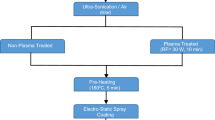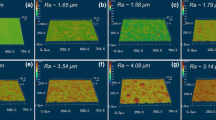Abstract
In this study, hexamethyldisiloxane was polymerized on the biaxially oriented polypropylene films by low-pressure radio frequency (RF) plasma. The samples were polymerized by using RF plasma in the frequency range of 13.56 MHz at the different polymerization times. The surface properties and chemical structure of samples were examined by contact angle measurement, atomic force microscopy, scanning electron microscopy and Fourier transformation infrared (FTIR). Also, the scratch behavior and the mechanical properties of samples were evaluated by using SPM lithography. In this work, some distinguishing changes were observed in properties of polymerized samples in comparison with raw sample. Results showed that the scratch resistance increased by prolonging polymerization time, whereas the surface energy decreased dramatically. It can be inferred from SPM and FTIR data that there is a direct relationship between scratch resistance and chemical composition of samples. Scratch resistance is mostly affected by silicon compounds deposited on the samples. Plasma polymerization causes changes in the chemical structure and surface properties of samples.










Similar content being viewed by others
References
Bhowmik S, Jana P, Chaki TK, Ray S (2004) Surface modification of PP under different electrodes of DC glow discharge and its physicochemical characteristics. Surf Coat Technol 185(1):81–91
Xiang C, Sue H, Chu J, Coleman B (2000) Scratch behavior and material property relationship in polymers. J Polym Sci B Polym Phys 39:47–59
Kurkcu P, Andena L, Pavan A (2012) An experimental investigation of the scratch behaviour of polymers: 1. Influence of rate-dependent bulk mechanical properties. Wear 290–291:86–93
Mirabedini SM, Arabi H, Salem A, Asiaban S (2007) Effect of low-pressure O2 and Ar plasma treatments on the wettability and morphology of biaxial-oriented polypropylene (BOPP) film. Prog Organ Coat 60:105–111
Shang HM, Wang Y, Limmer SJ, Chou TP, Takahashi K, Cao GZ (2005) Optically transparent super hydrophobic silica-based films. Thin Solid Films 472:37–43
Yasuda H (1985) Plasma polymerization. Academic Press, New York, London
Hinman PV, Bell AT, Shen M (1979) Composite reverse osmosis membranes prepared by plasma polymerization of allylamine. Evaluation of membrane performance for the treatment of washwater and its components. J Appl Polym Sci 23:3651–3656
Van Ooij WJ, Eufinger S, Ridgway TH (1996) DC-plasma-polymerized pyrrole. Plasma Polym 1:229–260
Eofinger S, Van Ooij WJ, Ridgway TH (1996) DC plasma-polymerization of pyrrole: comparison of films formed on anode and cathode. J Apply Polym Sci 61:1503–1514
Eufinger S, Van Ooij WJ, Conners KD (1996) DC-plasma polymerization of hexamethyldisiloxane Part II. Surf Interface Charact Films Depos Stainl Steel Substr Surf Interface Anal 24:841–855
Friedrich J (2011) Mechanisms of plasma polymerization reviewed from a chemical point of view. Plasma Process Polym 8:783–802
Nuntapichedkul B, Tantayanon S, Laohhasurayotin K (2014) Practical approach in surface modification of biaxially oriented polypropylene films for gravure printability. Appl Surf Sci 314:331–340
Mortazavi SH, Ghoranneviss M, Pilehvar S, Esmaeili S, Zargham S, Hashemi SE, Jodat H (2013) Effect of low-pressure nitrogen DC plasma treatment on the surface properties of biaxially oriented polypropylene, poly (methyl methacrylate) and polyvinyl chloride films. Plasma Sci Technol 15:362–367
Yu WHGLX, Chen AS, Science JSYu, Hu W, Chen GL (2016) Partial hydrophilic modification of biaxially oriented polypropylene film by an atmospheric pressure plasma jet with the allylamine monomer. Appl Surf Sci 387:957–964
Twomey B, Byrne G, Hynes A, O’Neill L, Dowling D (2009) Evaluation of the mechanical behaviour of nanometre-thick coatings deposited using an atmospheric pressure plasma system. Surf Coat Technol 203:2021–2029
Ji YY, Chang HK, Hong YC, Lee SH (2008) Formation of hydrophobic and water-repellent surface on polyester fibers using Ar/hexamethyldisiloxane plasma at atmospheric pressure. Jpn J Appl Phys 47(6R):4687
Chu J, Xiang C, Sue H-J, Hollis RD (2000) Scratch resistance of mineral-filled polypropylene materials. Polym Eng Sci 40:944–955
Kurkcu P, Andena L, Pavan A (2012) An experimental investigation of the scratch behaviour of polymers: 1. Influence of rate-dependent bulk mechanical properties. Wear 30:86–93
Jin X, Unertl WN (1992) Submicrometer modification of polymer surfaces with a surface force microscope. Appl Phys Lett 61:657–659
Yamamoto S, Yamada H, Tokumoto H (1995) Nanometer modifications of non-conductive materials using resist-films by atomic force microscopy. Jpn J Appl Phys 34:3396
Ogino T, Nishimura S, Shirakashi JI (2008) Scratch nanolithography on Si surface using scanning probe microscopy: influence of scanning parameters on groove size. Jpn J Appl Phys 47:712–715
Dasari A, Rohrmann J, Misra RDK (2002) Micro- and nanoscale evaluation of scratch damage in poly(propylene)s. Macromol Mater Engine 287:889–903
Jiang H, Browning R, Sue HJ (2009) Understanding of scratch-induced damage mechanisms in polymers. Polymer 50:4056–4065
Wong M, Lim GT, Moyse A, Reddy JN, Sue H-J (2004) A new test methodology for evaluating scratch resistance of polymers. Wear 256:1214–1227
Wong A, Moyse A, Lee F, Sue H-J (2004) Study of surface damage of polypropylene under progressive loading. J Mater Sci 39:3293–3308
Xiang C, Sue H-J, Chu J, Masuda K (2001) Roles of additives in scratch resistance of high crystallinity polypropylene copolymers. Polym Eng Sci 41:23–31
Dasaria A, Rohrmann J, Misra RDK (2004) On the scratch deformation of micrometric wollastonite reinforced polypropylene composites. Mater Sci Eng A 364:357–369
Surampadi NL, Pesacreta TC, Misra RDK (2007) The determining role of scratch indenter radius on surface deformation of high density polyethylene and calcium carbonate-reinforced composite. Mater Sci Eng A 456:218–229
Thridandapani RR, Mudaliar A, Yuan O, Misra RDK (2006) Near surface deformation associated with the scratch in polypropylene–clay nanocomposite: a microscopic study. Mater Sci Eng A 418:292–302
Briscoe BJ, Sinha SK (2003) Scratch resistance and localized damage characteristics of polymer surfaces: a review. Mater Sci Eng Technol 34:989–1002
ÖzgürBora M (2014) The influence of heat treatment on scratch behavior of polymethylmethacrylate (PMMA). Tribol Int 78:75–83
Ozgur Bora M, Coban O, Sinmazcelik T, Gunay V (2009) Effect of fiber orientation on scratch resistance in unidirectional carbon-fiber-reinforced polymer matrix composites. J Reinf Plast Compos 29:1476–1490
Surampadia NL, Pesacretab TC, Misraa RDK (2007) The determining role of scratch indenter radius on surface deformation of high density polyethylene and calcium carbonate-reinforced composite. Mater Sci Eng A 456:218–229
Abdel-Hamid HM (2005) Effect of electron beam irradiation on polypropylene films—dielectric and FT-IR studies. Solid State Electron 49:1163–1167
Michaeli W, Fonteiner I, Goebel S (2000) Characterization of the layer growth of plasma-polymerized HMDSO coatings on polycarbonate. Macromol Mater Eng 284:30–34
Chu J, Rumavo L, Coleman B (1998) Scratch and mar resistance of filled polypropylene. Mater Polym Eng Sci 38:1906
Misra RDK, Hadal R, Duncan SJ (2004) Surface damage behavior during scratch deformation of mineral reinforced polymer composites. Acta Mater 52:4363–4376
Miyashita K, Nishimura S, Toyofuku T, Shirakashi JI (2009) Nanoscale patterning of NiFe surface by scanning probe microscopy scratch nanolithography. J Vac Sci Technol B 27:953
Nie H-Y, Walzak MJ, McIntyre NS (2006) Scratch resistance anisotropy in biaxially oriented polypropylene and poly (ethylene terephthalate) films. Appl Surf Sci 253:2320–2326
Notargiacomo A, Foglietti V, Cianci E, Capellinik G, Adami M, Faraci P, Evangelisti F, Nicolini C (1999) Atomic force microscopy lithography as a nanodevice development. Tech Nanotechnol 10:458–463
Wenzel RN (1936) Resistance of solid surfaces to wetting by water. Ind Eng Chem 28:988–994
Author information
Authors and Affiliations
Corresponding author
Ethics declarations
Conflict of interest
The authors declare that there is no conflict of interest regarding the publication of this article.
Additional information
Publisher's Note
Springer Nature remains neutral with regard to jurisdictional claims in published maps and institutional affiliations.
Rights and permissions
About this article
Cite this article
Mortazavi, S.H., Jahazi, A. & Ghoranneviss, M. The effect of plasma polymerization of silicon compounds on the properties of biaxially oriented polypropylene (BOPP). Polym. Bull. 77, 1813–1828 (2020). https://doi.org/10.1007/s00289-019-02819-7
Received:
Revised:
Accepted:
Published:
Issue Date:
DOI: https://doi.org/10.1007/s00289-019-02819-7




